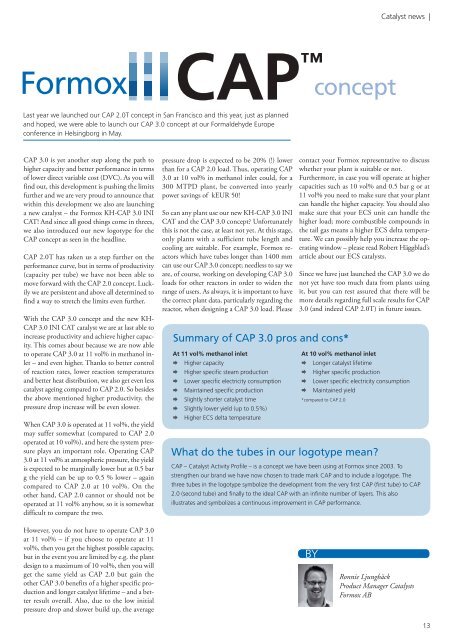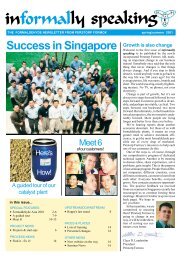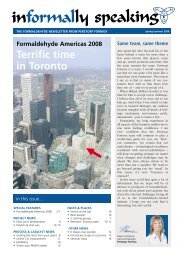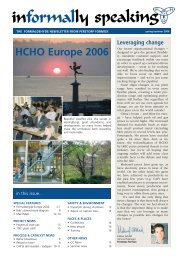Formaldehyde Europe 2012 - Perstorp Formox
Formaldehyde Europe 2012 - Perstorp Formox
Formaldehyde Europe 2012 - Perstorp Formox
You also want an ePaper? Increase the reach of your titles
YUMPU automatically turns print PDFs into web optimized ePapers that Google loves.
<strong>Formox</strong><br />
Last year we launched our cAP 2.0T concept in San Francisco and this year, just as planned<br />
and hoped, we were able to launch our cAP 3.0 concept at our <strong>Formaldehyde</strong> europe<br />
conference in Helsingborg in May.<br />
CAP 3.0 is yet another step along the path to<br />
higher capacity and better performance in terms<br />
of lower direct variable cost (DVC). As you will<br />
find out, this development is pushing the limits<br />
further and we are very proud to announce that<br />
within this development we also are launching<br />
a new catalyst – the <strong>Formox</strong> KH-CAP 3.0 INI<br />
CAT! And since all good things come in threes,<br />
we also introduced our new logotype for the<br />
CAP concept as seen in the headline.<br />
CAP 2.0T has taken us a step further on the<br />
performance curve, but in terms of productivity<br />
(capacity per tube) we have not been able to<br />
move forward with the CAP 2.0 concept. Luckily<br />
we are persistent and above all determined to<br />
find a way to stretch the limits even further.<br />
With the CAP 3.0 concept and the new KH-<br />
CAP 3.0 INI CAT catalyst we are at last able to<br />
increase productivity and achieve higher capacity.<br />
This comes about because we are now able<br />
to operate CAP 3.0 at 11 vol% in methanol inlet<br />
– and even higher. Thanks to better control<br />
of reaction rates, lower reaction temperatures<br />
and better heat distribution, we also get even less<br />
catalyst ageing compared to CAP 2.0. So besides<br />
the above mentioned higher productivity, the<br />
pressure drop increase will be even slower.<br />
When CAP 3.0 is operated at 11 vol%, the yield<br />
may suffer somewhat (compared to CAP 2.0<br />
operated at 10 vol%), and here the system pressure<br />
plays an important role. Operating CAP<br />
3.0 at 11 vol% at atmospheric pressure, the yield<br />
is expected to be marginally lower but at 0.5 bar<br />
g the yield can be up to 0.5 % lower – again<br />
compared to CAP 2.0 at 10 vol%. On the<br />
other hand, CAP 2.0 cannot or should not be<br />
oper ated at 11 vol% anyhow, so it is somewhat<br />
difficult to compare the two.<br />
However, you do not have to operate CAP 3.0<br />
at 11 vol% – if you choose to operate at 11<br />
vol%, then you get the highest possible capacity,<br />
but in the event you are limited by e.g. the plant<br />
design to a maximum of 10 vol%, then you will<br />
get the same yield as CAP 2.0 but gain the<br />
other CAP 3.0 benefits of a higher specific production<br />
and longer catalyst lifetime – and a better<br />
result overall. Also, due to the low initial<br />
pressure drop and slower build up, the average<br />
pressure drop is expected to be 20% (!) lower<br />
than for a CAP 2.0 load. Thus, operating CAP<br />
3.0 at 10 vol% in methanol inlet could, for a<br />
300 MTPD plant, be converted into yearly<br />
power savings of kEUR 50!<br />
So can any plant use our new KH-CAP 3.0 INI<br />
CAT and the CAP 3.0 concept? Unfortunately<br />
this is not the case, at least not yet. At this stage,<br />
only plants with a sufficient tube length and<br />
cooling are suitable. For example, <strong>Formox</strong> reactors<br />
which have tubes longer than 1400 mm<br />
can use our CAP 3.0 concept; needless to say we<br />
are, of course, working on developing CAP 3.0<br />
loads for other reactors in order to widen the<br />
range of users. As always, it is important to have<br />
the correct plant data, particularly regarding the<br />
reactor, when designing a CAP 3.0 load. Please<br />
Summary of CAP 3.0 pros and cons*<br />
At 11 vol% methanol inlet<br />
Æ Higher capacity<br />
Æ Higher specific steam production<br />
Æ Lower specific electricity consumption<br />
Æ Maintained specific production<br />
Æ Slightly shorter catalyst time<br />
Æ Slightly lower yield (up to 0.5%)<br />
Æ Higher ecS delta temperature<br />
BY<br />
concept<br />
catalyst news |<br />
contact your <strong>Formox</strong> representative to discuss<br />
whether your plant is suitable or not.<br />
Furthermore, in case you will operate at higher<br />
capacities such as 10 vol% and 0.5 bar g or at<br />
11 vol% you need to make sure that your plant<br />
can handle the higher capacity. You should also<br />
make sure that your ECS unit can handle the<br />
higher load; more combustible compounds in<br />
the tail gas means a higher ECS delta temperature.<br />
We can possibly help you increase the operating<br />
window – please read Robert Häggblad’s<br />
article about our ECS catalysts.<br />
Since we have just launched the CAP 3.0 we do<br />
not yet have too much data from plants using<br />
it, but you can rest assured that there will be<br />
more details regarding full scale results for CAP<br />
3.0 (and indeed CAP 2.0T) in future issues.<br />
At 10 vol% methanol inlet<br />
Æ Longer catalyst lifetime<br />
Æ Higher specific production<br />
Æ Lower specific electricity consumption<br />
Æ Maintained yield<br />
*compared to cAP 2.0<br />
What do the tubes in our logotype mean?<br />
cAP – catalyst Activity Profile – is a concept we have been using at <strong>Formox</strong> since 2003. To<br />
strengthen our brand we have now chosen to trade mark cAP and to include a logotype. The<br />
three tubes in the logotype symbolize the development from the very first cAP (first tube) to cAP<br />
2.0 (second tube) and finally to the ideal cAP with an infinite number of layers. This also<br />
illustrates and symbolizes a continuous improvement in cAP performance.<br />
Ronnie Ljungbäck<br />
Product Manager Catalysts<br />
<strong>Formox</strong> AB<br />
13








